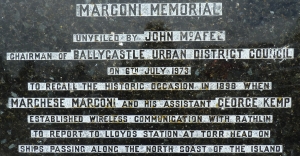Marconi - Have I Done The World Good or Have I Added A Menace?
We wonder how Marconi would get on with an iPad. He would be pleased to know his internet connection depends on a radio link but less pleased to know his pioneering work is being used to download pictures of cats.
Guglielmo Marconi was born in Bologna, Italy on April 25th 1874 to an Italian father and an Irish mother. His mother was Annie Jameson whose family owned the Jameson Whiskey Distillery in County Wexford, firmly establishing the link between radio hobbyists and strong drink.

Marconi is said to be the inventor of radio, sharing the 1909 Nobel Prize in Physics with Karl Ferdinand Braun for their part in the development of wireless technology, a century before Bluetooth. His main contribution was succeeding in making a commercial success of radio by marketing the best ideas at the time. Most of those ideas came from other people.
Even then, some of those ideas went back another fifty years. Nikola Tesla invented the oscillation transformer, a method of producing high-frequency alternating current. The technology has changed, a modern-day radio transmitter delivers radio-frequency alternating current into the antenna for Radio 4LW at Droitwich and at a much higher frequency provides the signal for your mobile phone to connect.
Heinrich Hertz had discovered that electro-magnetic waves existed and could be sent and received. Sir Oliver Lodge had developed a way of picking up these electro-magnetic signals in the Branley Coherer, a kind of crystal set. Sir William Crookes suggested that these radio waves could be used for communication without wires.
Such was the use of so many ideas that in 1943, the United States Supreme Court granted patent rights to Tesla, not Marconi, for the invention of radio.
In May 1898, Marconi met Sir Henry Hozier of Lloyd’s insurers of London. Lloyd’s issued a daily news letter, Lloyd’s First. So Marconi came to Ballycastle to undertake tests for Lloyds for sending the letter by wireless, the traditional methods of post and semaphore failing in bad weather.

The experimental work on Rathlin Island and in Ballycastle in 1898 was carried out by his assistants George Kemp, Edward Glanville and John Cecil who came from the island. They carried out experimental transmissions between Kenmara House on the cliff above the harbour and the east lighthouse on Rathlin Island using a 100 foot antenna at the White Lodge.
The tests created the historical link between the town and the pioneering developments that were taking place in wireless telegraphy even though Marconi only visited for four days during that time.
Marconi died in Rome on 20 July 1937 at age 63, following a series of heart attacks leaving us the wireless technology we enjoy today. With a little help from his friends...
Photographs by Caroline Dyas who gets out more than the writer, Bob Ellis.